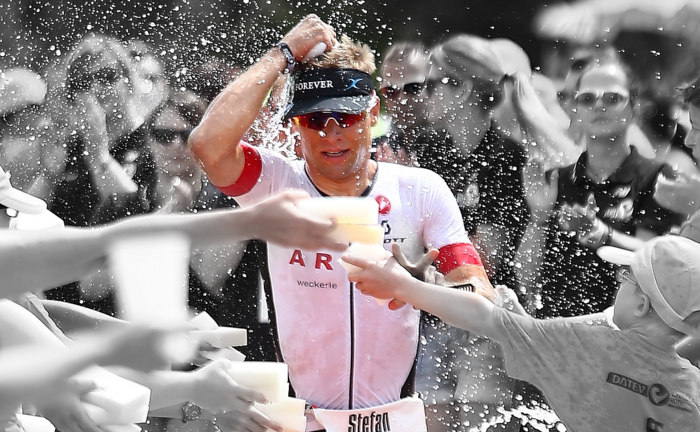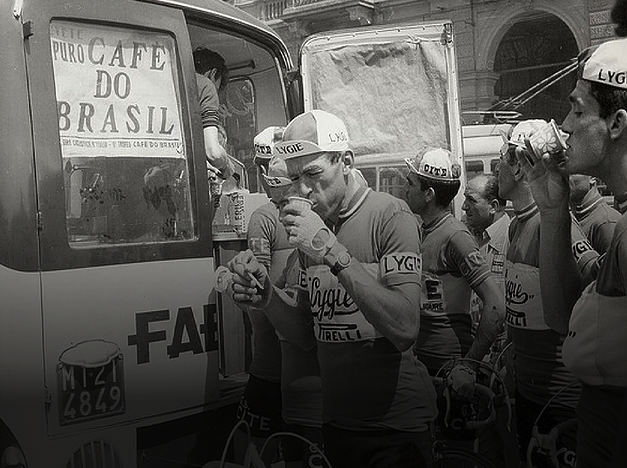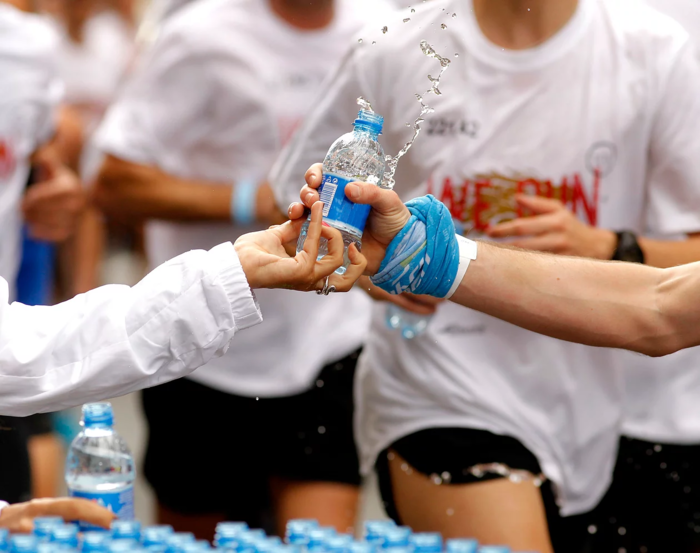How much you sweat will determine how much you need to drink. And calculating it is much easier than you think.

Why do we need to know sweat rate?
The goal of drinking during exercise is to prevent significant dehydration and to enable peak performance. It’s your sweat rate that determines your fluid requirements during exercise whether you are running a marathon, competing in long distance triathlon or playing a game of basketball or soccer.
Why do I need to know MY sweat rate?
Everyone sweats differently. Genetics, gender, training, and acclimatization all affect your sweat rate. In addition, the harder you work, the more you sweat. The hotter it is, the more you sweat. And other factors like humidity, sun, wind, and clothing will impact your sweat rate. We all know the heavy sweater who turns a training room into a swimming pool in less than an hour, and we all know the other person who hasn’t broken a sweat even after 1 hour of hard work!
What’s the general idea of measuring sweat rate?
The simplest case is measuring sweat rate when exercising without consuming any food or drink and without going to the bathroom. If you weigh yourself before and after your exercise, the difference in weight is primarily due to sweat loss. Convert that to fluid volume and you have sweat loss (1kg = 1L). When you divide that sweat loss by the exercise time, you have sweat rate.
Getting a little more complicated, if you drank while you exercised, then your total sweat loss is the amount you determined from weight loss PLUS the amount you drank. To get sweat rate, it’s the same idea as previously: just divide total sweat loss by exercise time.
If you went to the bathroom, the math is simple, but the measurement might not be. Your sweat loss would be total sweat loss from above MINUS the volume of urine.
What’s the detailed procedure?
Equipment:
First, there are a couple things you’ll need to do your measurement:
- Scale (accurate to 0.1kg / 0.2lbs)
- Kitchen Scale (optional)1
- Measuring Cup (optional)1
- A towel
- A calculator (or the attached Excel download)
Data Collection:
Next, it’s time to collect data your exercise data.
- Empty your bladder and record your weight (nude or with minimal clothing); record your “weight before”
- Perform your workout or race; record / remember exactly how much you drank; record your “intake volume” and record your “exercise time”.
- If you did urinate, record the estimated / measured volume as “urination”
- Weigh yourself after exercise; remove clothing or wear swimsuit; towel dry; record your “weight after”
Calculations:
Now we’ll do calculations
-
Calculate “weight loss”
weight loss ____ kg weight before ____ kg - weight after ____ kg Note: if you gained weight, the loss would be negative.
-
To Calculate “total sweat loss”
total sweat loss ____ L weight loss ____ kg + intake volume ____ L - urination ____ L - Final step is calculating “sweat rate” sweat rate = total sweat loss / exercise time (hrs)
These calculations are easiest if all units are converted to Liters and kilograms. Here are some conversions:
| Measure | From | To Metric |
|---|---|---|
| Weight | 1 pound | 0.454 kg |
| Weight | 1 stones | 6.35 kg |
| Fluid Volume | 1 fluid ounce | 0.029574 L |
Should I measure more than once?
Often sweat rates are measured as a one-off. This gives you a sweat rate for those conditions in which you did the measurement: a sweat rate for that sport, that temperature and humidity, for that intensity of exercise with those clothes you were wearing, etc. If any of these variables changes, sweat rate will change as well. It’s most important to measure in the conditions for which you are doing nutrition plans; given that conditions will vary, repeated measurements in different conditions are essential.
Also, there will be errors introduced by the accuracy of your scale, temperature measurement, fluid intake measurement, etc. Repeated measurement for a certain set of conditions will allow reduction in the error. Your sweat rate estimations will never be 100% accurate, but they will give you a much better idea how much to drink than simply relying on thirst.
A little more on weight loss
As you exercise you will burn fat and carbohydrate. This contributes to the weight loss you have measured. But, this weight loss is usually a small portion of the total weight loss and doesn’t introduce a significant error into the sweat rate calculations. Further, if you were consuming carbohydrate during your exercise, this would reduce the amount of this error.
Knowing your sweat rate is important. The more you measure, the more your knowledge will increase: a very literal example of knowledge is power.
- When determining “intake volume”, it’s easiest if you only need to count known volumes of full bottles or cups consumed. But, it’s more often likely that you’ll have partial bottles. Several options exist for the dealing with partial bottle remainder… drink the remainder, measure the remainder, or weigh the partial bottle consumed. If drinking the remainder, do so before weighing yourself after the exercise. If measuring, use measuring cup; then, subtract the remainder from the total of full bottles including the one you just measured. If weighing, use kitchen scale to weigh the bottle that has remainder and to also weigh full bottle; then add the difference (weight of full – weight of remainder) to the rest of your consumption from all other full bottles.





